-
 +86-0557-3781111 / +86-0571-56396277
+86-0557-3781111 / +86-0571-56396277
 +86-0557-3781111 / +86-0571-56396277
+86-0557-3781111 / +86-0571-56396277
Designing home appliance packaging boxes to withstand the bumps and jolts encountered during transportation is crucial for protecting products and ensuring they arrive at their destination in perfect condition. The packaging must be robust enough to absorb impact forces and vibrations while maintaining the integrity of the appliance inside. Here’s how you can design effective packaging to withstand these challenges:
1. Use Strong and Durable Outer Boxes
Material Selection: The outer box should be made of high-quality, double-walled or triple-walled corrugated cardboard. These materials are strong and can absorb a significant amount of impact, protecting the contents from external forces.
Why It Helps: The strength of the cardboard is essential for resisting crushing and protecting against external impacts caused by bumps, drops, or stacking during transit.
2. Cushioning and Shock Absorption
Internal Foam Inserts: Use foam inserts (e.g., polyurethane, polystyrene) to cushion the appliance. These materials can absorb shock and prevent the appliance from direct contact with the walls of the box, reducing the likelihood of damage.
Air Pillows or Inflatable Cushions: These are lightweight and can be placed around the appliance to cushion it from impact. They absorb vibrations and prevent shifting during transportation.
Bubble Wrap: Wrapping fragile components (like glass or electronic parts) in bubble wrap adds another layer of shock absorption, preventing scratching or cracking during bumps.
Foam Pads and Molded Pulp: For delicate or heavy items, molded foam or pulp inserts can be used to securely hold the appliance in place, protecting it from sideways forces or bumping.
3. Prevent Internal Movement
Custom Inserts or Fittings: Create custom-fit inserts made from foam or molded pulp that hold the appliance securely in place. This prevents it from moving inside the box during handling and transit.
Void Fillers: Use paper fillers, foam peanuts, or air cushions to fill any empty spaces inside the box. These fillers prevent the appliance from shifting or colliding with other objects inside the box during transit.
Straps or Supports: In some cases, straps or plastic supports inside the box can be used to firmly hold the appliance in place, especially for larger items, to prevent movement that might cause damage.
4. Reinforce Edges and Corners
Corner Protectors: Add foam corner protectors or cardboard edge protectors to shield vulnerable corners of the appliance from being crushed or damaged during bumps. Corners are often the first points to absorb impact.
Reinforced Box Corners: Reinforcing the box corners with extra layers of cardboard helps distribute impact forces more evenly, preventing corner crushing that could damage both the packaging and the appliance inside.
Foam or Cardboard Surround: For fragile items (like screens or glass), use foam or a layer of cardboard around the appliance’s edges to further shield it from direct impacts.
5. Strengthen the Bottom of the Box
Double-Layered Bottom: Ensure that the bottom of the box is reinforced with an additional layer of cardboard to withstand any heavy impacts or weight stacking. The extra strength is especially important when appliances are stacked on top of each other during transit.
Cross-bracing: Add extra bracing material or diagonal strips of cardboard inside the box to help the bottom withstand external pressure and to provide more stability for heavier appliances.

6. Design for Stacking Stability
Box Shape: The box should have a stable shape (usually rectangular) to prevent it from toppling over when stacked. A uniform shape ensures better stability during stacking and reduces the risk of damage from sudden shifts or pressure.
Stacking Guidelines: Design the packaging with clear stacking instructions (e.g., "Do not stack" or "Keep upright") to prevent mishandling during transportation.
Weight Distribution: Ensure the weight of the appliance is distributed evenly within the packaging. Balanced weight distribution minimizes the risk of damage caused by toppling or crushing under other packages.
7. Use of Shock-Absorbent Coatings
Vibration Damping Coatings: Certain vibration-damping coatings can be applied to the packaging materials to absorb additional vibrations during transport. These can be especially useful for appliances with delicate electronics or sensitive components.
Anti-slip Coatings: Applying anti-slip coatings to the exterior of the box can help prevent the appliance from sliding inside the box during transit, reducing the chances of abrasions or damage caused by movement.
8. Design for Ease of Handling
Handle with Care: Ensure the packaging has clear "Handle with Care" or "This Side Up" labels, making it easier for handlers to understand how to transport the box without causing damage.
Ergonomic Handles: Consider adding reinforced cut-out handles to the packaging for easier handling. Strong, ergonomic handles allow the package to be safely lifted and moved, reducing the chance of the appliance being dropped.
9. Proper Sealing
Reinforced Seals: Use strong adhesive tapes (such as polypropylene or polyester tapes) to secure the box and prevent it from opening during transit. This ensures the package remains closed and the appliance remains well-protected from external forces.
Tamper-Evident Seals: Consider using tamper-evident seals to ensure that the packaging cannot be opened or altered during the shipping process.
10. Testing and Quality Control
Drop Testing: Packaging designs should be tested using drop tests to simulate real-world shipping conditions. This helps ensure the packaging can withstand impacts from various heights and orientations.
Compression Testing: Testing for compression resistance ensures the packaging can handle weight from stacking and heavy loads without collapsing.
Vibration Testing: Simulating vibrations and shocks typically encountered during transit helps verify that the packaging is capable of protecting the appliance.
Annhiu Address: Yishan Road and Qingshengou Road Intersection, Suzhou Economic Development Zone, Anhui, China
Tel: +86-0557-3781111
E-mail: [email protected]
Hangzhou Address: Building 3, No.286, Renliang Road, Renhe Street, Yuhang District, Hangzhou, Zhejiang, China
Tel: +86-0571-56396277
E-mail: [email protected]
Copyright © Hangzhou Shengpin Packaging Co., Ltd. All Rights Reserved.
